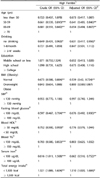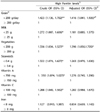1. Cook JD, Lipschitz DA, Miles LE, Finch CA. Serum ferritin as a measure of iron stores in normal subjects. Am J Clin Nutr. 1974; 27:681–687.

2. Gudjoncik A, Guenancia C, Zeller M, Cottin Y, Vergely C, Rochette L. Iron, oxidative stress, and redox signaling in the cardiovascular system. Mol Nutr Food Res. 2014; 58:1721–1738.

3. Lee BK, Kim Y, Kim YI. Association of serum ferritin with metabolic syndrome and diabetes mellitus in the South Korean general population according to the Korean National Health and Nutrition Examination Survey 2008. Metabolism. 2001; 60:1416–1424.

4. Vari IS, Balkau B, Kettaneh A, Andre P, Tichet J, Fumeron F, Caces E, Marre M, Grandchamp B, Ducimetiere P. DESIR Study Group. Ferritin and transferrin are associated with metabolic syndrome abnormalities and their change over time in a general population: Data from an Epidemiological Study on the Insulin Resistance Syndrome (DESIR). Diabetes Care. 2007; 30:1795–1801.

5. Liu JM, Hankinson SE, Stampfer MJ, Rifai N, Willett WC, Ma J. Body iron stores and their determinants in healthy postmenopausal US women. Am J Clin Nutr. 2003; 78:1160–1167.

6. Zacharski LR, Ornstein DL, Woloshin S, Schwartz LM. Association of age, sex, and race with body iron stores in adults: analysis of NHANES III data. Am Heart J. 2000; 140:98–104.

7. Lecube A, Hernández C, Pelegrí D, Simó R. Factors accounting for high ferritin levels in obesity. Int J Obes (Lond). 2008; 32:1665–1669.

8. Fleming DJ, Tucker KL, Jacques PF, Dallal GE, Wilson PW, Wood RJ. Dietary factors associated with the risk of high iron stores in the elderly Framingham Heart Study cohort. Am J Clin Nutr. 2002; 76:1375–1384.

9. Hallberg L. Bioavailability of dietary iron in man. Annu Rev Nutr. 1981; 1:123–147.

10. Rajpathak S, Ma J, Manson J, Willett WC, Hu FB. Iron intake and the risk of type 2 diabetes in women: a prospective cohort study. Diabetes Care. 2006; 29:1370–1376.
11. Shi Z, Hu X, Yuan B, Pan X, Dai Y, Holmboe-Ottesen G, Byles JE. Strong negative association between intake of tofu and anemia among Chinese adults in Jiangsu, China. J Am Diet Assoc. 2008; 108:1146–1153.

12. Kim MH, Bae YJ. Postmenopausal vegetarians' low serum ferritin level may reduce the risk for metabolic syndrome. Biol Trace Elem Res. 2012; 149:34–41.

13. Kim BJ, Ahn SH, Bae SJ, Kim EH, Lee SH, Kim HK, Choe JW, Koh JM, Kim GS. Iron overload accelerates bone loss in healthy postmenopausal women and middle-aged men: a 3-year retrospective longitudinal study. J Bone Miner Res. 2012; 27:2279–2290.

14. Atsma F, Bartelink ML, Grobbee DE, van der Schouw YT. Postmenopausal status and early menopause as independent risk factors for cardiovascular disease: a meta-analysis. Menopause. 2006; 13:265–279.

15. Seo SK, Yun BH, Chon SJ, Lee YJ, Han EJ, Park JH, Cho S, Choi YS, Lee BS. Association of serum ferritin levels with metabolic syndrome and subclinical coronary atherosclerosis in postmenopausal Korean women. Clin Chim Acta. 2015; 438:62–66.

16. Cho GJ, Shin JH, Yi KW, Park HT, Kim T, Hur JY, Kim SH. Serum ferritin levels are associated with metabolic syndrome in postmenopausal women but not in premenopausal women. Menopause. 2011; 18:1120–1124.

17. Jian J, Pelle E, Huang X. Iron and menopause: does increased iron affect the health of postmenopausal women? Antioxid Redox Signal. 2009; 11:2939–2943.

18. Soustre Y, Dop MC, Galan P, Hercberg S. Dietary determinants of the iron status in menstruating women. Int J Vitam Nutr Res. 1986; 56:281–286.
19. Garry PJ, Goodwin JS, Hunt WC. Iron status and anemia in the elderly: new findings and a review of previous studies. J Am Geriatr Soc. 1983; 31:389–399.

20. Beck KL, Conlon CA, Kruger R, Coad J. Dietary determinants of and possible solutions to iron deficiency for young women living in industrialized countries: a review. Nutrients. 2014; 6:3747–3776.

21. Cade JE, Moreton JA, O'Hara B, Greenwood DC, Moor J, Burley VJ, Kukalizch K, Bishop DT, Worwood M. Diet and genetic factors associated with iron status in middle-aged women. Am J Clin Nutr. 2005; 82:813–820.

22. Liu JM, Hankinson SE, Stampfer MJ, Rifai N, Willett WC, Ma J. Body iron stores and their determinants in healthy postmenopausal US women. Am J Clin Nutr. 2003; 78:1160–1167.

23. Rural Development Administration. National Rural Resources Development Institute (KR). Food Composition Table. 7th ed. Suwon: Rural Development Administration;National Rural Resources Development Institute;2006.
24. Guglielmi V, D'Adamo M, Bellia A, Ciotto RT, Federici M, Lauro D, Sbraccia P. Iron status in obesity: An independent association with metabolic parameters and effect of weight loss. Nutr Metab Cardiovasc Dis. 2015; 25:541–547.

25. Kunutsor SK, Apekey TA, Walley J, Kain K. Ferritin levels and risk of type 2 diabetes mellitus: an updated systematic review and meta-analysis of prospective evidence. Diabetes Metab Res Rev. 2013; 29:308–318.

26. Azadbakht L, Kimiagar M, Mehrabi Y, Esmaillzadeh A, Hu FB, Willett WC. Soy consumption, markers of inflammation, and endothelial function: a cross-over study in postmenopausal women with the metabolic syndrome. Diabetes Care. 2007; 30:967–973.
27. Hallberg L. Wheat fiber, phytates and iron absorption. Scand J Gastroenterol Suppl. 1987; 129:73–79.

28. Milman N, Schultz-Larsen K. Iron stores in 70-year-old Danish men and women. Evaluation in 469 individuals by serum ferritin and hemoglobin. Aging (Milano). 1994; 6:97–103.

29. Galán P, Hercberg S, Soustre Y, Dop MC, Dupin H. Factors affecting iron stores in French female students. Hum Nutr Clin Nutr. 1985; 39:279–287.
30. Hallberg L, Bengtsson C, Lapidus L, Lindstedt G, Lundberg PA, Hultén L. Screening for iron deficiency: an analysis based on bonemarrow examinations and serum ferritin determinations in a population sample of women. Br J Haematol. 1993; 85:787–798.

31. Fleming DJ, Jacques PF, Dallal GE, Tucker KL, Wilson PW, Wood RJ. Dietary determinants of iron stores in a free-living elderly population: The Framingham Heart Study. Am J Clin Nutr. 1998; 67:722–733.

32. Guenther PM, Kott PS, Carriquiry AL. Development of an approach for estimating usual nutrient intake distributions at the population level. J Nutr. 1997; 127:1106–1112.

33. O'Neil CE, Keast DR, Fulgoni VL, Nicklas TA. Food sources of energy and nutrients among adults in the US: NHANES 2003-2006. Nutrients. 2012; 4:2097–2120.









 PDF
PDF ePub
ePub Citation
Citation Print
Print



 XML Download
XML Download